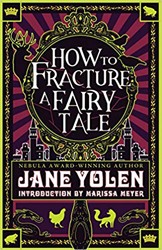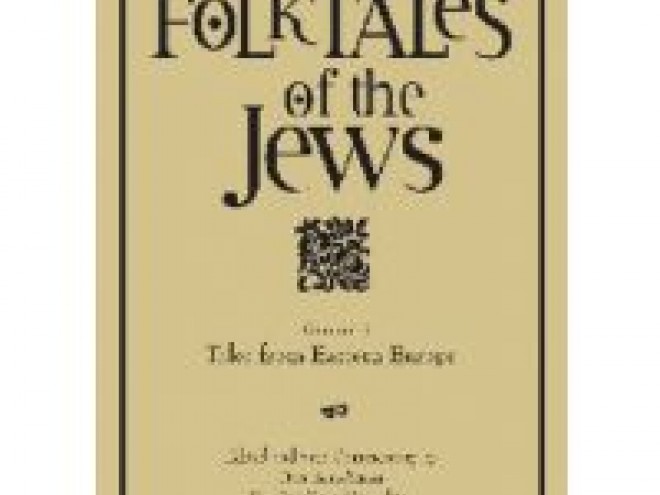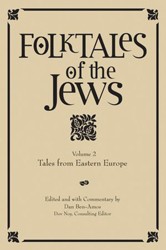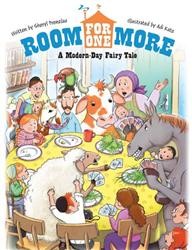by Sharon Elswit
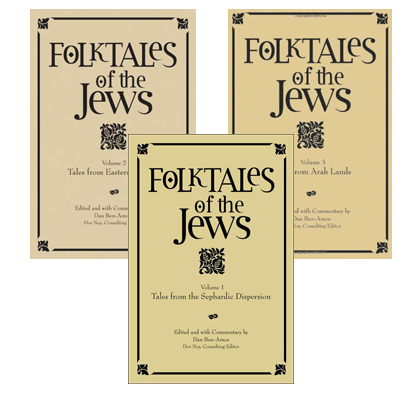 Throughout the ages, folklore has spoken to people. From pulpits and hearth fires and in classrooms, these stories forge a connection between the generations, pass on the values of a community, teach lessons, and help us make sense of ourselves and understand the world around us. They connect us with each other, a shared history of knowing. They help us face our fears. They validate our dreams. They heal. They entertain. And they offer us choices. A story attributed to the Preacher of Dubno makes a case for Truth being much more palatable when it is dressed up as a Parable.
Throughout the ages, folklore has spoken to people. From pulpits and hearth fires and in classrooms, these stories forge a connection between the generations, pass on the values of a community, teach lessons, and help us make sense of ourselves and understand the world around us. They connect us with each other, a shared history of knowing. They help us face our fears. They validate our dreams. They heal. They entertain. And they offer us choices. A story attributed to the Preacher of Dubno makes a case for Truth being much more palatable when it is dressed up as a Parable.
Times do change, but underlying human truths and struggles do not. Relationships within families, between people and government, between friends and lovers — these go on. These are the subjects of folktales. There will always be a gossip, a miser, and a cheater. There will always be loneliness, sickness, and loss. There will always be someone else who bravely speaks up or cleverly thwarts a nefarious plan. Our folktales take this messy world and help us think about it by taking us on a journey outside of our own lives. They help us remember. They challenge us to make the world a better place within our own communities and outside. As in the tale of a captive bird that learns from the example of his cousin how to feign death and fly away, stories themselves show us how.
First told orally and then written down, these stories have been passed down from grandparents to children and their children, from teachers, from rabbis, from storytellers. We now find them, too, printed in collections and picture books and on the web. Sharing folktales with others is a gift. There are even folktales about the value of participating by telling stories and by listening:
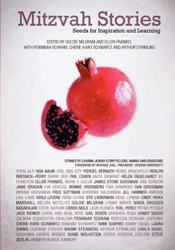 There are stories for each stage of the life cycle. In one, Lailah, the angel, tells unborn children the history of mankind and their lives to be, and then touches them right above the upper lip so they forget all the moment they are born. Need a story to celebrate a couple getting married? Wish for the couple to have children who will thrive just like them, as told in “The Wedding Blessing” in Peninnah Schram’s Jewish Stories One Generation Tells Another. Share “The Magic Gourd” by Debra Gordon Zaslow from Goldie Milgram’s Mitzvah Stories, where a couple postpones using a wedding gift which may only be used once by relying on themselves and each other throughout their lives together. Trouble with marriage? A man who has had no luck providing for his family is harshly sent by his wife to bang a drum in the cemetery, where he encounters a sympathetic bear. With children? In one tale, a father anguished by his teenage daughter’s escapades prays for her to become a bat. Aging? An elderly cantor does not take well to being replaced and sends his raspy voice to haunt the young new cantor. In another story, Moses pleads that it is not yet his time to die. Three sons, whose father has just died, wonder which of them now possesses the true ring. Two sons in another story try to puzzle out just what is the treasure their father said he was leaving them, as they continue to work the land they have inherited.
There are stories for each stage of the life cycle. In one, Lailah, the angel, tells unborn children the history of mankind and their lives to be, and then touches them right above the upper lip so they forget all the moment they are born. Need a story to celebrate a couple getting married? Wish for the couple to have children who will thrive just like them, as told in “The Wedding Blessing” in Peninnah Schram’s Jewish Stories One Generation Tells Another. Share “The Magic Gourd” by Debra Gordon Zaslow from Goldie Milgram’s Mitzvah Stories, where a couple postpones using a wedding gift which may only be used once by relying on themselves and each other throughout their lives together. Trouble with marriage? A man who has had no luck providing for his family is harshly sent by his wife to bang a drum in the cemetery, where he encounters a sympathetic bear. With children? In one tale, a father anguished by his teenage daughter’s escapades prays for her to become a bat. Aging? An elderly cantor does not take well to being replaced and sends his raspy voice to haunt the young new cantor. In another story, Moses pleads that it is not yet his time to die. Three sons, whose father has just died, wonder which of them now possesses the true ring. Two sons in another story try to puzzle out just what is the treasure their father said he was leaving them, as they continue to work the land they have inherited.
Folktales are not just for children. In one story, a man who doubts his wife’s fidelity takes revenge with an arrow shot through Rabbi Adam’s magic mirror. In another, a woman’s brothers bring the husband who has turned away from her to the king to hear a story of a trespassing lion so he will know that his wife did remain true to him. Howard Schwartz’s fantastical collections, such as Leaves from the Garden of Eden, Elijah’s Violin, Miriam’s Tambourine, and Lilith’s Cave spin timeless tales filled with sensual imagery and supernatural occurrences.
The stories that take hold of us and won’t let go, we keep and change. We need the narrative, the wonder, the danger, the humor, and the magic. Folktales are malleable. That is their resilience. Stories have changed with the teller and with the countries in which people live. Some sumptuous Jewish tales either inspired or were inspired by Tales from the Arabian Nights. Humorous Joha tales differ from the Djuha trickster/fool in Arabic lore only by some of the traditions portrayed. And Peninnah Schram and Rachayl Eckstein Davis turned the American story of the boy who goes looking for a little red house with no windows and no doors and a star inside into The Apple Tree’s Discovery, a tale of self-esteem, with special relevance for Rosh Hashannah. Some general Internet anecdotes that reflect Jewish values are included in Seymour Rossel’s newest collection The Essential Jewish Tales. Just about eight of the stories told by fifty-four rabbis in Laney Becker’s Three Times Chai, have been adapted from universal tales.
More recently, it seems that adaptation is also going the other way around, with Jewish stories as a base for other cultural adaptations. You might not call Tim Burton’s The Corpse Bride a Jewish story, but his film certainly took flight from the Hasidic story of the young man who playfully places his wedding ring on a tree root he finds sticking up like a finger from the ground only to find out that he is now wedded to a demon. General versions of It Could Always Be Worse, that tale of the rabbi who keeps advising the man in the overcrowded house to bring more animals inside each day, abound. Eric A. Kimmel is our most prolific story culture mixer. He recently set an Arabic Joha character in a Jewish Yemenite story of “The Answered Prayer.” His out-of-print Mishka, Pishka, and Fishka combines Ukrainian and Jewish culture in tales told to him by his Jewish grandmother.
Good stories will out. You can find a version of “The Treasure,” where a man goes to Prague looking for the treasure he dreamt about only to discover that the treasure has been buried back at home, set in China. There is a Jewish version of “The Magic Pomegranate” and one with three Middle Eastern princes and a special orange. There are African and Chinese versions of the story where a man brings water instead of wine to the barrel for a communal celebration, thinking no one will notice when it mixes in, and several Jewish takes, including the one by Nina Jaffe where neither husband nor wife put in the coins they promised while saving up to buy hamantaschen for Purim. And stories with Chelm-like humor have been told by the Uygur People in western China.
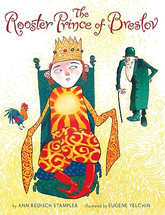 Current retellers pick stories they love and dig into character and motivation to make them relevant in today’s environment. Some exciting story reinterpretations have made an appearance in picture book form in the last few years. Gathering Sparks by Howard Schwartz, Ann Redisch Stampler’s The Wooden Sword, and Kimmel’s Joseph and The Sabbath Fish reach out to connect with new subtleties and warmth. One can truly believe that the prince in Stampler’s The Rooster Prince of Breslov has accepted acting like a human when, on his own, he thinks to share the blanket with his shivering teacher. Each year brings new retellings of the Golem legend and “If Not Higher,” for these are stories which stir powerful emotions, unforgettably strong and beautiful. Possession in “The Dybbuk” has been explored through dance, puppets, video, and theater, some of them parodies.
Current retellers pick stories they love and dig into character and motivation to make them relevant in today’s environment. Some exciting story reinterpretations have made an appearance in picture book form in the last few years. Gathering Sparks by Howard Schwartz, Ann Redisch Stampler’s The Wooden Sword, and Kimmel’s Joseph and The Sabbath Fish reach out to connect with new subtleties and warmth. One can truly believe that the prince in Stampler’s The Rooster Prince of Breslov has accepted acting like a human when, on his own, he thinks to share the blanket with his shivering teacher. Each year brings new retellings of the Golem legend and “If Not Higher,” for these are stories which stir powerful emotions, unforgettably strong and beautiful. Possession in “The Dybbuk” has been explored through dance, puppets, video, and theater, some of them parodies.
There are original tales, too, created with beloved folklore characters. Kimmel caused a sensation in 1994 with Hershel and the Hanukkah Goblins, based on the character Hershel of Ostropol. He also refashioned some traditional Chelm stories in The Jar of Fools so that the events take place during Hanukkah and invented some of his own Chelm tales, a difficult task to do well.
When things have already happened, then it is poetry which brings succor or rejoices with us and gives words to our feelings so right on that a breath catches. When we stand on the cusp or in the middle of an event and decisions have to be made, then we need a story with characters to help guide us through. Here is the captive bird wondering how he will get free; here is the brother who has sent his own brother to Azazel, rather than help him prepare for Passover; here is the king who goes into a little hut to remind himself how it is for the people he rules; here is the wife whose husband has wrongly accused her of misconduct; here is the grandmother hugging her grandson after he almost drowns in the ocean and, in the same breath, berating God for not returning his hat; here is the daughter who does not want to wear her mother’s wedding dress. There are folktales for all of these situations. What happens next may be fantastical — demons holding the girl prisoner inside her new dress — but she has our empathy. Meaning grows from understanding. An old tale freshly told, one that has taken the hand of people through years and even centuries, may bring laughter and wisdom, warnings and warmth to befriend us. We may become the human heroes of our own journeys with folktales to light the way.
Sharon Elswit, head hibrarian at Léman Manhattan Preparatory School, is author of the first and second edition of The Jewish Story Finder: A Guide to 668 Tales Listing Subjects and Sources, as well as The East Asian Story Finder.
 Throughout the ages, folklore has spoken to people. From pulpits and hearth fires and in classrooms, these stories forge a connection between the generations, pass on the values of a community, teach lessons, and help us make sense of ourselves and understand the world around us. They connect us with each other, a shared history of knowing. They help us face our fears. They validate our dreams. They heal. They entertain. And they offer us choices. A story attributed to the Preacher of Dubno makes a case for Truth being much more palatable when it is dressed up as a Parable.
Throughout the ages, folklore has spoken to people. From pulpits and hearth fires and in classrooms, these stories forge a connection between the generations, pass on the values of a community, teach lessons, and help us make sense of ourselves and understand the world around us. They connect us with each other, a shared history of knowing. They help us face our fears. They validate our dreams. They heal. They entertain. And they offer us choices. A story attributed to the Preacher of Dubno makes a case for Truth being much more palatable when it is dressed up as a Parable. Times do change, but underlying human truths and struggles do not. Relationships within families, between people and government, between friends and lovers — these go on. These are the subjects of folktales. There will always be a gossip, a miser, and a cheater. There will always be loneliness, sickness, and loss. There will always be someone else who bravely speaks up or cleverly thwarts a nefarious plan. Our folktales take this messy world and help us think about it by taking us on a journey outside of our own lives. They help us remember. They challenge us to make the world a better place within our own communities and outside. As in the tale of a captive bird that learns from the example of his cousin how to feign death and fly away, stories themselves show us how.
First told orally and then written down, these stories have been passed down from grandparents to children and their children, from teachers, from rabbis, from storytellers. We now find them, too, printed in collections and picture books and on the web. Sharing folktales with others is a gift. There are even folktales about the value of participating by telling stories and by listening:
- a father and daughter who have become separated recognize each other through a shared tale about a shofar
- a story passed down about a certain ritual and prayer performed by the Baal Shem Tov continues to help save the world, though the story itself is all that remains
- King Solomon gets at the truth by telling a story and judging people’s reactions
- a disciple releases another man from the lie he has been living by bringing him a story which lets him know he has been forgiven
- a man brings what comfort he can to others in Auschwitz by listening to their stories
- a haughty rabbi learns to make a difference by changing the tone of the stories he tells
- a king realizes how unfairly he has treated his wife when he overhears her telling a doll the story of her unhappiness
- and finally, as Avi Weiss asserts, people need to interact with the fire of stories in the Torah to forge new connections through the generations.
The storyteller Joel ben Izzy makes a strong case in The Beggar King and the Secret of Happiness for the relevance and necessity of folklore in resolving problems in one’s personal life. After he lost his voice, it was that title story — a folktale where King Solomon loses his identity when Asmodeus throws his ring across the world — which seemed to embody the storyteller’s own struggles to reclaim his world and his career.
Folktales are not just for children. In one story, a man who doubts his wife’s fidelity takes revenge with an arrow shot through Rabbi Adam’s magic mirror. In another, a woman’s brothers bring the husband who has turned away from her to the king to hear a story of a trespassing lion so he will know that his wife did remain true to him. Howard Schwartz’s fantastical collections, such as Leaves from the Garden of Eden, Elijah’s Violin, Miriam’s Tambourine, and Lilith’s Cave spin timeless tales filled with sensual imagery and supernatural occurrences.
The stories that take hold of us and won’t let go, we keep and change. We need the narrative, the wonder, the danger, the humor, and the magic. Folktales are malleable. That is their resilience. Stories have changed with the teller and with the countries in which people live. Some sumptuous Jewish tales either inspired or were inspired by Tales from the Arabian Nights. Humorous Joha tales differ from the Djuha trickster/fool in Arabic lore only by some of the traditions portrayed. And Peninnah Schram and Rachayl Eckstein Davis turned the American story of the boy who goes looking for a little red house with no windows and no doors and a star inside into The Apple Tree’s Discovery, a tale of self-esteem, with special relevance for Rosh Hashannah. Some general Internet anecdotes that reflect Jewish values are included in Seymour Rossel’s newest collection The Essential Jewish Tales. Just about eight of the stories told by fifty-four rabbis in Laney Becker’s Three Times Chai, have been adapted from universal tales.
More recently, it seems that adaptation is also going the other way around, with Jewish stories as a base for other cultural adaptations. You might not call Tim Burton’s The Corpse Bride a Jewish story, but his film certainly took flight from the Hasidic story of the young man who playfully places his wedding ring on a tree root he finds sticking up like a finger from the ground only to find out that he is now wedded to a demon. General versions of It Could Always Be Worse, that tale of the rabbi who keeps advising the man in the overcrowded house to bring more animals inside each day, abound. Eric A. Kimmel is our most prolific story culture mixer. He recently set an Arabic Joha character in a Jewish Yemenite story of “The Answered Prayer.” His out-of-print Mishka, Pishka, and Fishka combines Ukrainian and Jewish culture in tales told to him by his Jewish grandmother.
Good stories will out. You can find a version of “The Treasure,” where a man goes to Prague looking for the treasure he dreamt about only to discover that the treasure has been buried back at home, set in China. There is a Jewish version of “The Magic Pomegranate” and one with three Middle Eastern princes and a special orange. There are African and Chinese versions of the story where a man brings water instead of wine to the barrel for a communal celebration, thinking no one will notice when it mixes in, and several Jewish takes, including the one by Nina Jaffe where neither husband nor wife put in the coins they promised while saving up to buy hamantaschen for Purim. And stories with Chelm-like humor have been told by the Uygur People in western China.
 Current retellers pick stories they love and dig into character and motivation to make them relevant in today’s environment. Some exciting story reinterpretations have made an appearance in picture book form in the last few years. Gathering Sparks by Howard Schwartz, Ann Redisch Stampler’s The Wooden Sword, and Kimmel’s Joseph and The Sabbath Fish reach out to connect with new subtleties and warmth. One can truly believe that the prince in Stampler’s The Rooster Prince of Breslov has accepted acting like a human when, on his own, he thinks to share the blanket with his shivering teacher. Each year brings new retellings of the Golem legend and “If Not Higher,” for these are stories which stir powerful emotions, unforgettably strong and beautiful. Possession in “The Dybbuk” has been explored through dance, puppets, video, and theater, some of them parodies.
Current retellers pick stories they love and dig into character and motivation to make them relevant in today’s environment. Some exciting story reinterpretations have made an appearance in picture book form in the last few years. Gathering Sparks by Howard Schwartz, Ann Redisch Stampler’s The Wooden Sword, and Kimmel’s Joseph and The Sabbath Fish reach out to connect with new subtleties and warmth. One can truly believe that the prince in Stampler’s The Rooster Prince of Breslov has accepted acting like a human when, on his own, he thinks to share the blanket with his shivering teacher. Each year brings new retellings of the Golem legend and “If Not Higher,” for these are stories which stir powerful emotions, unforgettably strong and beautiful. Possession in “The Dybbuk” has been explored through dance, puppets, video, and theater, some of them parodies. There are original tales, too, created with beloved folklore characters. Kimmel caused a sensation in 1994 with Hershel and the Hanukkah Goblins, based on the character Hershel of Ostropol. He also refashioned some traditional Chelm stories in The Jar of Fools so that the events take place during Hanukkah and invented some of his own Chelm tales, a difficult task to do well.
When things have already happened, then it is poetry which brings succor or rejoices with us and gives words to our feelings so right on that a breath catches. When we stand on the cusp or in the middle of an event and decisions have to be made, then we need a story with characters to help guide us through. Here is the captive bird wondering how he will get free; here is the brother who has sent his own brother to Azazel, rather than help him prepare for Passover; here is the king who goes into a little hut to remind himself how it is for the people he rules; here is the wife whose husband has wrongly accused her of misconduct; here is the grandmother hugging her grandson after he almost drowns in the ocean and, in the same breath, berating God for not returning his hat; here is the daughter who does not want to wear her mother’s wedding dress. There are folktales for all of these situations. What happens next may be fantastical — demons holding the girl prisoner inside her new dress — but she has our empathy. Meaning grows from understanding. An old tale freshly told, one that has taken the hand of people through years and even centuries, may bring laughter and wisdom, warnings and warmth to befriend us. We may become the human heroes of our own journeys with folktales to light the way.
Related: Jewish Folktales Reading List
Sharon Elswit, author of The Jewish Story Finder and a school librarian for forty years in NYC, now resides in San Francisco, where she shares tales aloud in a local JCC preschool and volunteers with 826 Valencia to help students write their own stories and poems.
